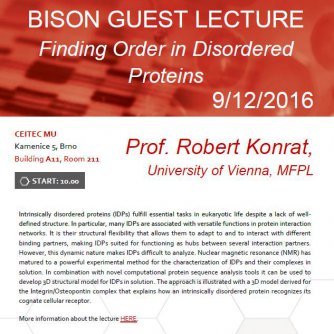Abstract
Intrinsically disordered proteins (IDPs) fulfill essential tasks in eukaryotic life despite a lack of well-defined structure. In particular, many IDPs are associated with versatile functions in protein interaction networks. It is their structural flexibility that allows them to adapt to and to interact with different binding partners, making IDPs suited for functioning as hubs between several interaction partners. However, this dynamic nature makes IDPs difficult to analyze. Nuclear magnetic resonance (NMR) has matured to a powerful experimental method for the characterization of IDPs and their complexes in solution. In combination with novel computational protein sequence analysis tools it can be used to develop 3D structural model for IDPs in solution. The approach is illustrated with a 3D model derived for the Integrin/Osteopontin complex that explains how an intrinsically disordered protein recognizes its cognate cellular receptor.
Prof. Konrat is the head of Computational Biology and Biomolecular NMR Spectroscopy.
Research focus: The sequencing of the human genome has provided a ‘parts list’ of the human inventory comprising potential therapeutic targets for the pharmaceutical and biotechnology industry. In order to cope with this huge number of targets we introduced a new theoretical conception of protein structural biology (meta-structure) that can be used for protein sequence-to-function annotation and drug design. A hallmark of our research is the integrative application of this novel conception and sophisticated NMR spectroscopy directed towards a better understanding of fundamental biological processes. Finally, as much of protein function is predicated on dynamics, we are developing novel methodological approaches that combine biochemistry, bioorganic chemistry and NMR spectroscopy to unravel the microscopic details of functionally important protein plasticity.








